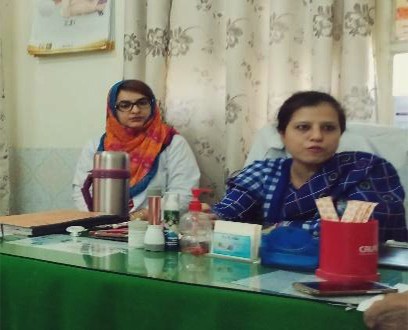Speeches Shim

In late 2017, before Drs. Mahvish and Humera began working as gynecologists at the Hazrat Khadija Hospital in Hyderabad, Pakistan, there was an acute shortage of female doctors providing maternal health services at the hospital. This meant that patients had long wait times; those that waited were not always seen by a health provider equipped to deal with their needs; and overall confidence in the health system was low.
Throughout Pakistan’s Sindh province, where Hyderabad is located, there were insufficient staff to meet patient needs, and staff that were available were not properly trained and lacked clear roles and responsibilities within the system.
To address these issues, USAID worked with the Department of Health of Sindh DoHS to conduct a census of primary and secondary health facilities in 23 districts, with the aim of assessing their functionality, including what services were available when and whether the facility was able to meet the needs of patients seeking care. The census showed that 62 percent of specialist positions, including gynecologists like Drs. Mahvish and Humera, were vacant.
USAID helped the DoHS use this information to improve their staffing, and, as a direct result, ability to deliver health services. A Human Resources for Health Strategy was developed to help plan and manage human resources in Sindh. The census data was utilized by the Departments of Health and Finance to prioritize needed positions, determine the costs to fill them, and identify funding within the budget to meet those costs. As a result, the DoHS recruited 5,803 doctors, medical officers, women medical officers, and specialists, and has factored the ongoing cost of these positions into their budget. Additionally, a district action plan prioritizing short-term health worker training was created and the equivalent of $205,000 USD from Sindh’s own budget was allocated to the 2016 and 2017 trainings.
USAID also worked with the DoHS to enroll a number of provincial and district health managers in certificate and degree courses at universities. These health managers now have the skills and ability to carry out planning for districts, including budget development and performance tracking. This has created a new class of managerial positions that will continue to help districts in Sindh effectively hire, train, and manage their health workers.
These improvements in the health system and health workforce have already yielded patient benefits. There has been a 23% increase in antenatal care visits compared to just 5 months prior, and a 32% increase in voluntary family planning visits. Patient confidence in public sector health facilities has also increased – particularly with female patients. Drs. Mahvish and Humera are able to address more complicated medical needs, which means women that come to the Hazrat Khadija Hospital are able to receive appropriate, timely, and often life-saving care, resulting in improved confidence in the health system.
By partnering with the Government of Sindh to improve the planning for and management of health staff, USAID is making health systems in Pakistan more efficient and better able to deliver services. When USAID partners with governments to identify and address gaps that can be filled with their own resources, we improve service capacity and help advance their journey to self-reliance.

Comment
Make a general inquiry or suggest an improvement.